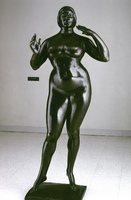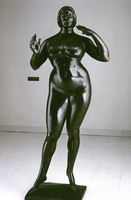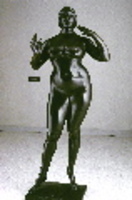| dc.description | Working in Paris during the early twentieth century, Gaston Lachaise found his lifelong muse in the ample figure of Isabel Dutaud Nagle, an American woman ten years his senior who was then married. When she left France for America in 1905, the young sculptor followed, never returning home. In America, Lachaise's talents as a sculptor blossomed in the company of Isabel, whom he married in 1917.
It is remarkable that during the first fifteen years of Lachaise's mature career (1906–21), when he was developing an individual style, he was also employed as full-time assistant to two noted academic sculptors: Henry Hudson Kitson in Boston (1906–12) and Paul Manship in New York (1913–21). While working at these jobs to support himself, Lachaise nevertheless found time for his own sculptural projects, producing some of his most original work.
Lachaise began the monumental "Standing Woman," his first full-size figure, upon arriving in New York in 1912. Over the next several years he made numerous revisions before exhibiting it publicly, as a painted plaster, at Stephan Bourgeois Gallery, New York, in February 1918. It was on this occasion that Bourgeois gave the work the poetic title "Elevation," a name that both Isabel and Lachaise disliked. Because of Lachaise's ever-precarious financial situation, the piece was not cast in bronze until 1927, in anticipation of his forthcoming exhibition at Brummer Gallery, New York, in February–March 1928. Several castings, some executed posthumously, exist of this sculpture.
The anatomical features of "Standing Woman" are undoubtedly based on those of Isabel, who was also the inspiration for a series of small plaster and bronze statuettes of a few years earlier. Her fully rounded torso is easily identified by the high narrow waistline, the broad flat back and buttocks, and the wide full breasts. In marked constrast to these massive horizontal forms are the elegantly poised hands and the tapered legs and slender feet, raised on tiptoe, upon which the entire weight of the figure is gracefully, and amazingly, supported. Although inspired by Lachaise's beloved, the figure in "Standing Woman" goes beyond the particulars of any single individual to suggest the more archetypal image of the ideal woman. | en_US |



